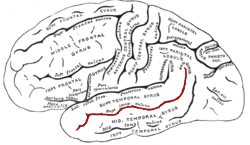In studies on dysfunctional social cognition in neurological disorders, such as what is observed in people with high-functioning autism, the role of the superior temporal sulcus in processing social information has been identified as the mechanism that lies at the root of these impairments in social interpretation. [30]
Autism and schizophrenia
Children with high-functioning autism have been reported to have no significant change in superior temporal sulcus activation for biological motion compared to non-biological motion, which suggests that the superior temporal sulcus is not specifically activated in the processing of biological motion like it is in children without autism. [30] In subjects with schizophrenia, another neurological disorder associated with significant impairments to social cognition, these social impairments have been linked to an alteration in posterior superior temporal sulcus activation in affective theory of mind, emotional recognition, and the interpretation of neutral facial expressions. [31] More specifically, it was determined that schizophrenic subjects exhibited hyperactivity within the posterior superior temporal sulcus of the right hemisphere in processing neutral facial expressions, but they also exhibited hypoactivity within this same region for emotional recognition and affective theory of mind. [31] This same study also found impaired connectivity between the right and left hemispheres of the posterior superior temporal sulcus in the processing of affective theory of mind. [31] Another recent study showed an inverse relationship between glutamate concentrations within the superior temporal sulcus and neuroticism scores assessed by questionnaire was found in subjects with schizophrenia, which suggests that elevations in glutamate concentrations may act as a compensatory mechanism that allows those with schizophrenia to prevent neuroticism. [32]
Agnosia
Various disorders of the STS have been documented in which patients fail to recognize a certain stimulus, but still exhibit subcortical processing of the stimulus, this is known as an agnosia. Furthermore, agnosia is often linked to experiencing hardship in regard to stimuli recognition despite presenting otherwise normal or intact sensory functioning. Agnosia is found to disturb higher-order centers of the brain which also include cortical regions such as the posterior parietal cortex and occipitotemporal regions. [33] [34]
Pure auditory agnosia (agnosia without aphasia) is found in patients who can't identify non-speech sounds such as coughing, whistling, and crying but have no deficit in speech comprehension. Speech agnosia is known as an incapability to comprehend spoken words despite intact hearing, speech production, and reading ability. Patients show a recognition of the familiarity of a word, but are not able to recall its meaning. Phonagnosia is characterized as an inability to recognize familiar voices, while having other auditory abilities. Patients exhibited a double dissociation with either an inability to match names or faces with a certain famous voice, or to discriminate familiar voices from unfamiliar ones. Visual agnosia can be broken into separate disorders in regard to what is being recognized. [35] An inability to recognize written words is known as alexia or word blindness, while an inability to recognize familiar faces is known as prosopagnosia. Prosopagnosia has been shown to have a similar double dissociation as phonagnosia in that some patients show an impairment of memory for familiar faces while others show impairment when discriminating familiar faces from unfamiliar ones.
Dual Pathway Model:
Gregory Hickok and David Poeppel's model proposed what is known as the dual pathway or the dual-stream model. This model explores the perception and experience of speech stimuli. The model implies that two streams process information at the perception of speech - the ventral and dorsal stream. The ventral stream aids in the comprehension and recognition of speech input passing through the ears and entering the brain. On the other hand, the dorsal stream allows an individual to respond to said input as the speech stimuli further undergoes processing by the superior temporal gyrus. This correlates to the superior temporal sulcus because the dual pathway model occurs next after "spectrotemporal analysis" is carried out through the auditory cortex. [36] [37]
Determination of Speech versus Non-Speech:
The superior temporal sulcus has an important part in the processing of human speech - specifically comprehension and perception of human voices/spoken language. According to "The superior temporal sulcus" (( Howard 2023 )), research studies have been conducted by Blinder (2000) and Beline (2000) that examine the way in which the superior temporal sulcus reacts to various forms of stimuli especially speech and non-speech stimuli. Results show that the superior temporal sulcus is favorable towards response to human voices. [36] [38]
Phonological Neighborhoods:
Phonological neighborhoods are "neighborhoods" or groups of words that all have common or similar sounds. Research shows how much the superior temporal sulcus plays a vital role in processing and understanding of phonological neighborhoods. Words experience classification based on the amount of other words with similar sounds. High neighborhood density words describe words that are similar phonetically to several other words. On the other hand, low neighborhood density describes words that have few similar sounding words. [39] [40]

